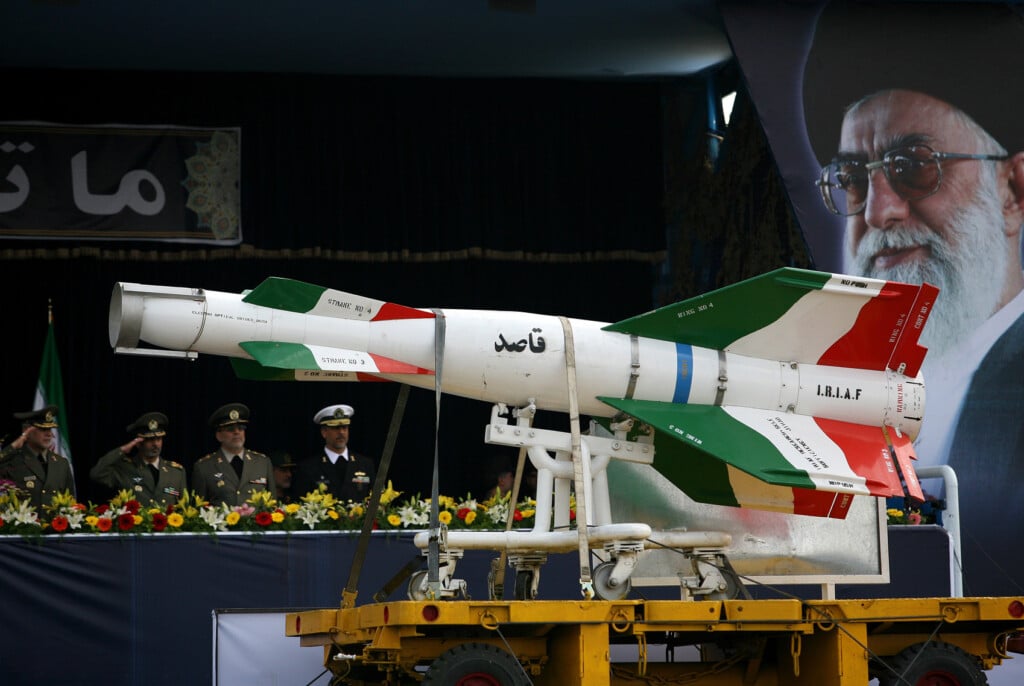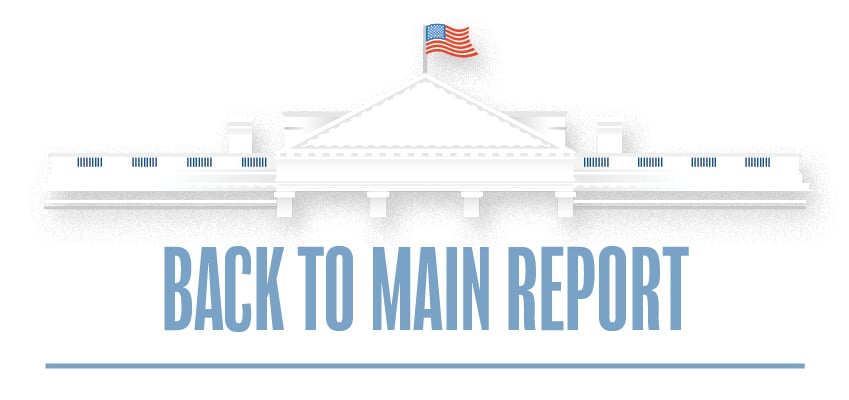January 31, 2019 | Midterm Assessment
Midterm Assessment: Iran
Contents
January 31, 2019 | Midterm Assessment
Midterm Assessment: Iran
Current Policy
For almost two years, before President Trump ordered the withdrawal of U.S. troops from Syria in December 2018, the Trump administration pursued an Iran policy based on the use of all instruments of national power to stop Tehran from engaging in a wide array of aggressive and malign behaviors that defy global norms. In his May 21, 2018 speech, “A New Iran Strategy,” Secretary of State Mike Pompeo called on Iran to end verifiably its nuclear weapons and advanced ballistic missile programs, cease its support for terrorism and the destabilization of foreign governments, release all hostages, and halt its aggression against Israel and other U.S. allies.1
To achieve these objectives, the administration designed a strategy to pressure the regime – diplomatically, economically, and militarily. To that end, the administration walked away from the nuclear deal known as the Joint Comprehensive Plan of Action (JCPOA) and reinstated the comprehensive sanctions that had forced Iran to the negotiating table in 2013. The focal point of U.S. strategy was to intensify the Iranian regime’s ongoing liquidity crisis, which threatened to cripple its economy as a whole. The secretary of state also insisted the U.S. “will advocate tirelessly for the Iranian people,” who endure grave human rights violations and pervasive corruption. The Trump administration made it clear that it did not seek regime change, but would take advantage of the Islamic Republic’s deficit of legitimacy. In short, the U.S. purported to implement a policy of maximum pressure.
The administration designed its comprehensive pressure campaign to resemble the one Ronald Reagan deployed against the Soviet Union. The cornerstone of his strategy was the recognition that the Soviet Union was an aggressive and revolutionary, yet internally fragile, regime. Reagan outlined his policy in National Security Decision Directive 75 in 1983. The plan included a massive defense buildup, economic warfare, support for anti-Soviet proxy forces and dissidents to combat Moscow globally, and an all-out offensive against the regime’s ideological legitimacy.
The Trump administration withdrew from the JCPOA because the nuclear deal permitted Iran to reach the threshold of a nuclear weapons capability without even cheating. Rather, by waiting for key constraints to sunset, Tehran would have an industrial-size enrichment program, a near-zero breakout time, advanced centrifuges that are easier to operate in a clandestine manner, long-range ballistic missiles, and access to advanced conventional weaponry. In the meantime, its economy could grow with increased foreign investment and decreased vulnerability to sanctions.
The administration made it clear that it was prepared to reestablish full diplomatic and commercial relations with Tehran if the regime negotiated a deal that corrects the shortcomings of the JCPOA. As Secretary Pompeo indicated, this would include an end to all uranium enrichment and plutonium reprocessing, “unqualified access” to all sites for UN weapons inspectors, full disclosure of previous nuclear weapons programs, and the termination of Iran’s nuclear-capable missile program. An agreement would also require the release of all U.S. and foreign hostages and the cessation of Iran’s support for terrorism and other aggressive conduct in the Middle East.
The Trump administration’s strategy came down to putting the regime in Tehran to a stark choice between a fundamental change in its behavior and an unrelenting pressure campaign to severely weaken the Islamic Republic. However, Trump’s decision to pull U.S. troops from Syria raises serious doubts about the president’s commitment to pressuring Iran on every front.

An Iranian surface-to-surface Ghasedak missile is driven past portraits of Iran’s late founder of the Islamic Republic, Ayatollah Ali Khamenei, during the annual army day military parade on April 17, 2008 in Tehran, Iran. (Photo by Majid/Getty Images)
Assessment
Tehran is reeling from the combination of sanctions pressure and the popular discontent aggravated by the regime’s own repression and mismanagement. Yet the impending U.S. withdrawal from Syria diminishes the pressure on Tehran at a critical moment.
The most successful part of Trump’s Iran strategy has been the reinstatement of comprehensive sanctions suspended as part of the nuclear deal. While European governments declined to re-impose sanctions, scores of foreign investors, including major multinational corporations, are abandoning the Iranian market.2 The IMF and World Bank now forecast a deepening recession. The value of the Iranian rial is plummeting while inflation skyrockets. Sanctions have cut back oil exports by about 30 percent, costing the regime billions at a time when it is desperate for hard currency. The U.S. has also renewed its challenge to the clerical regime’s legitimacy by resuming the effort to sanction corrupt officials and human rights violators.
While European governments declined to re-impose sanctions, scores of foreign investors, including major multinational corporations, are abandoning the Iranian market.
Economic pressure is rising despite the efforts of European governments to salvage the JCPOA by preserving its economic incentives for Tehran. European efforts include setting up special purpose vehicles for international payments, resisting the expulsion of Iran from the SWIFT financial messaging system, and deterring compliance with U.S. sanctions by activating a blocking statue.
In contrast to the effectiveness of sanctions, the administration’s regional strategy to counter Iranian influence in the Middle East is on life support thanks to the planned withdrawal of U.S. troops from Syria.
Trump’s principal advisers recognized that the presence of U.S. forces in Syria denied key terrain and natural resources to Iran, Hezbollah, Russia, and Bashar al-Assad’s regime, while costing the United States relatively little and while our forces incurred very few casualties. Iran, in particular, will appreciate Trump’s removal of the most important obstacle to its completion of a “land bridge,” or ground corridor, from Western Iran to the Mediterranean. The U.S. military presence in Syria also deterred Turkish aggression against the Syrian Kurds, who lost thousands of fighters whom had joined the U.S.-led campaign against the Islamic State. For good reason, U.S. adversaries are cheering the withdrawal from Syria while friends and allies question our wisdom and reliability.
The collapse of the U.S. effort to push back against Iran’s regional aggression means that U.S. policy now depends almost entirely on sanctions. However, sanctions alone are not a strategy. In isolation, they serve the same purpose the nuclear deal did for Barack Obama: to cover America’s retreat from the region.
The Trump administration’s Iran policy now suffers from a lack of bipartisan support. Only a broad and deep bipartisan consensus in Congress made possible the tough sanctions laws that forced Iran into nuclear negotiations in 2013. Regrettably, the Obama administration pressed forward with the JCPOA despite majority opposition in Congress. This polarization persists. If Democrats retake the White House in 2020, the new president is likely to re-enter the JCPOA and suspend sanctions once again, though he or she will face the prospect of key restrictions on Iran’s nuclear, missile, and military programs lapsing during their first and second terms.
Iranian Supreme Leader Ali Khamenei appears to recognize this dynamic and may decide to play for time, counting on Trump’s defeat in 2020. Khamenei likely understands that Trump’s decision on Syria signals a lack of staying power, fickleness, and fatigue. It also signals contempt for U.S. allies. Thus, Tehran may now welcome a diplomatic process whose purpose is to waste time and blunt the sanctions campaign. For that reason, Trump’s expressions of interest in meeting Hassan Rouhani play right into Tehran’s hands. In this regard, the negotiations with North Korea are a cautionary tale.

Islamic Revolutionary Guard Corps and Basij fighters. (Wikimedia Commons)
Recommendations
- Ensure the SWIFT financial messaging service immediately disconnects any Iranian banks engaged in illicit transactions. Iranian banks have a record of abusing SWIFT’s humanitarian channel to evade sanctions. The U.S. should push for the immediate disconnection of Iranian banks and the sanctioning of any non-Iranian bank or company that helps an Iranian bank engage in such misconduct.
- Persuade the European Central Bank to stop clearing euro-based Iranian transactions through its Target2 settlement system. Target2 explicitly forbids transactions involving money laundering, terror finance, and nuclear proliferation.
- Issue a permanent USA PATRIOT Act Section 311 determination that Iran is a “jurisdiction of primary money laundering concern.” The determination should require enhanced auditing and due diligence for any company doing business with Iran. It should strengthen “Know Your Customer’s Customer” (KYCC) rules for Iran-related transactions, and undo late 2016 revisions to Treasury’s guidelines on the Islamic Revolutionary Guard Corps (IRGC), U.S. dollar, and KYCC.
- Sanction Iran’s major sources of funding. The United States should sanction companies over which the IRGC and other malign actors exert substantial control but not a majority share. It should also target market segments under IRGC influence, such as mining, metallurgy, construction, telecommunications, and computer science. Similarly, Washington should expand sanctions beyond the supreme leader’s $200-billion corporate conglomerate to target charitable trusts, or bonyads, including the Mostazafan Foundation and Astan Quds Razavi. Likewise, sanction the National Development Fund, a sovereign wealth fund. Finally, the State Department should designate the IRGC as a Foreign Terrorist Organization (FTO).
- Constantly challenge the legitimacy of the clerical regime by emphasizing its corruption and human rights violations. Trump should issue a new Iran-related executive order that broadens the categories of individuals subject to sanctions for corruption and human rights violations. The administration should also encourage condemnations and sanctions by foreign leaders. It should also announce a new “Iran Kleptocracy Initiative” to expose corrupt officials’ hidden assets.
- Help the Iranian people evade censorship and access credible information. The administration should foster the development of tools for Iranian citizens’ safe online communication, and consider the provision of internet access via satellite. It should direct federal agencies responsible for foreign broadcasting to highlight corruption and human rights violations. It should support organizations that assist and train pro-democracy activists and dissidents.
- Work to restore the U.S.-European partnership that helped restrain Iran prior to the JCPOA. The administration should build on concerns that Europe shares about Iranian missiles, human rights violations, and regional instability, which increases refugee flows.
- Lift the blanket U.S. travel ban on Iranian citizens, but expel those linked to the regime. The U.S. should welcome ordinary Iranians, while denying their oppressors the privilege of visiting or studying in the U.S.
- Expand efforts to block the U.S.-designated Mahan Air’s flights to Europe and the Gulf. Use secondary sanctions to target Mahan’s ticketing agents and ground services operators as well as banks facilitating the airline’s payments for airport services.
- Attach secondary “travel-related” sanctions to travel bans issued on Iranian officials and related proxies.
- Ensure the U.S. has a credible military option to reinforce its economic and financial pressure campaign. This must include a military plan to prevent Iran from producing a nuclear bomb and a credible U.S.-supported military strategy to counter Iranian influence in the region. The U.S. should provide allies like Israel all the needed support to resist Iranian aggression.
- Suspend the withdrawal of U.S. troops from Syria. Even if most troops are withdrawn, maintain a contingent of Special Operations Forces at the al-Tanf in eastern Syria, which sits astride the optimal route for Iran’s land bridge to the Mediterranean.
